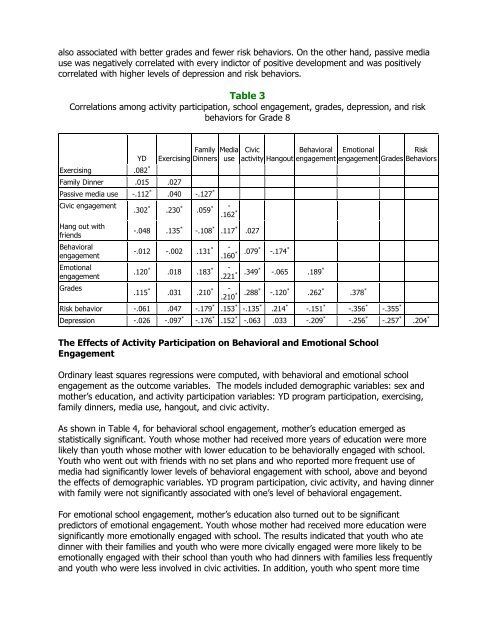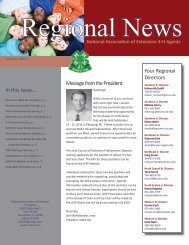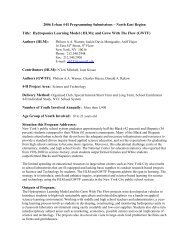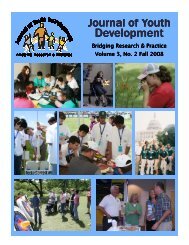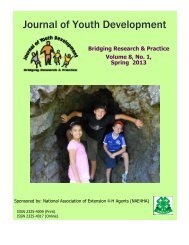Winter 2008 - Vol. 3 No. 3 - National Association of Extension 4-H ...
Winter 2008 - Vol. 3 No. 3 - National Association of Extension 4-H ...
Winter 2008 - Vol. 3 No. 3 - National Association of Extension 4-H ...
- No tags were found...
Create successful ePaper yourself
Turn your PDF publications into a flip-book with our unique Google optimized e-Paper software.
also associated with better grades and fewer risk behaviors. On the other hand, passive mediause was negatively correlated with every indictor <strong>of</strong> positive development and was positivelycorrelated with higher levels <strong>of</strong> depression and risk behaviors.Table 3Correlations among activity participation, school engagement, grades, depression, and riskbehaviors for Grade 8YDExercising .082 *ExercisingFamily Dinner .015 .027Passive media use -.112 * .040 -.127 *Civic engagementHang out withfriendsBehavioralengagementEmotionalengagementGradesFamily MediaDinners use.302 * .230 * .059 * -.162 *-.048 .135 * -.108 * .117 * .027Civicactivity Hangout-.012 -.002 .131 * -.160 * .079 * -.174 *Behavioralengagement.120 * .018 .183 * -.221 * .349 * -.065 .189 *.115 * .031 .210 * -.210 * .288 * -.120 * .262 * .378 *Emotionalengagement GradesRisk behavior -.061 .047 -.179 * .153 * -.135 * .214 * -.151 * -.356 * -.355 *RiskBehaviorsDepression -.026 -.097 * -.176 * .152 * -.063 .033 -.209 * -.256 * -.257 * .204 *The Effects <strong>of</strong> Activity Participation on Behavioral and Emotional SchoolEngagementOrdinary least squares regressions were computed, with behavioral and emotional schoolengagement as the outcome variables. The models included demographic variables: sex andmother’s education, and activity participation variables: YD program participation, exercising,family dinners, media use, hangout, and civic activity.As shown in Table 4, for behavioral school engagement, mother’s education emerged asstatistically significant. Youth whose mother had received more years <strong>of</strong> education were morelikely than youth whose mother with lower education to be behaviorally engaged with school.Youth who went out with friends with no set plans and who reported more frequent use <strong>of</strong>media had significantly lower levels <strong>of</strong> behavioral engagement with school, above and beyondthe effects <strong>of</strong> demographic variables. YD program participation, civic activity, and having dinnerwith family were not significantly associated with one’s level <strong>of</strong> behavioral engagement.For emotional school engagement, mother’s education also turned out to be significantpredictors <strong>of</strong> emotional engagement. Youth whose mother had received more education weresignificantly more emotionally engaged with school. The results indicated that youth who atedinner with their families and youth who were more civically engaged were more likely to beemotionally engaged with their school than youth who had dinners with families less frequentlyand youth who were less involved in civic activities. In addition, youth who spent more time


